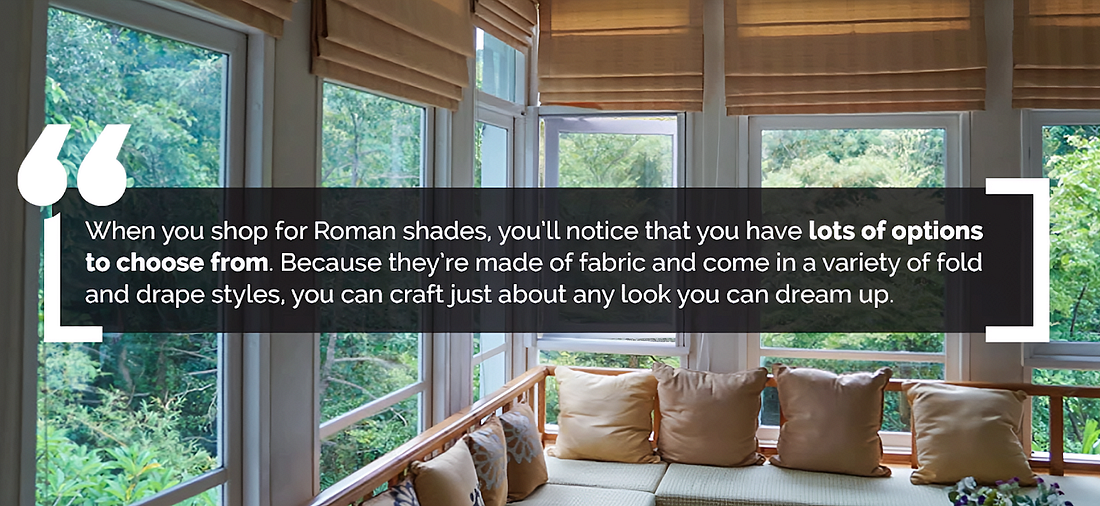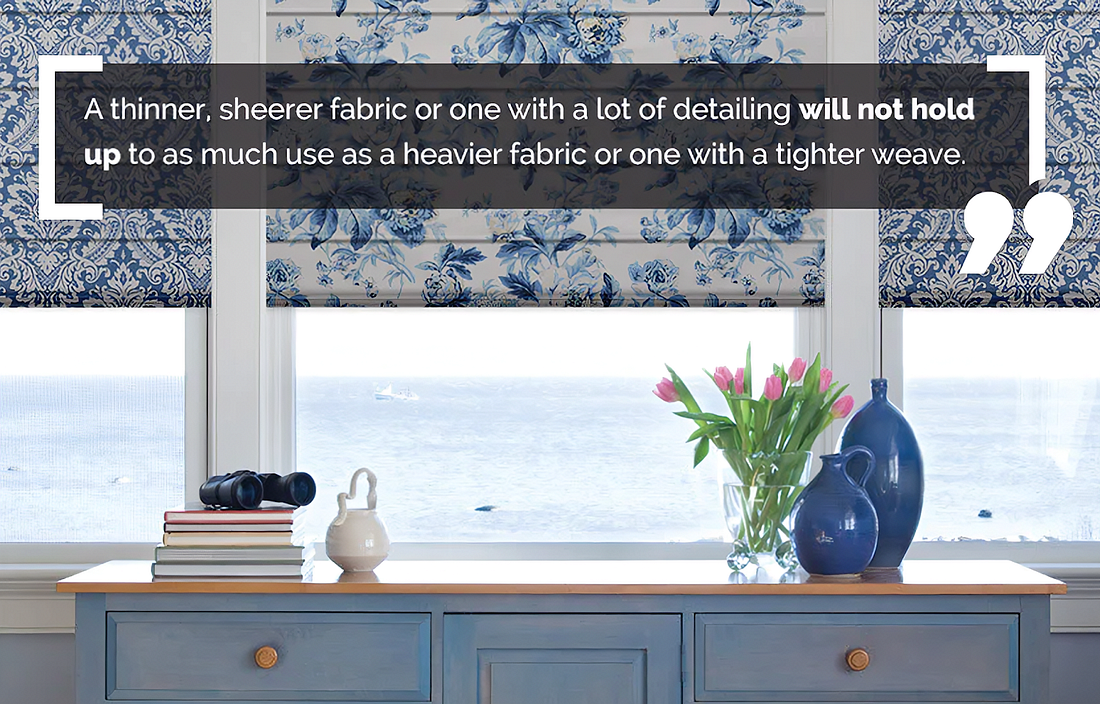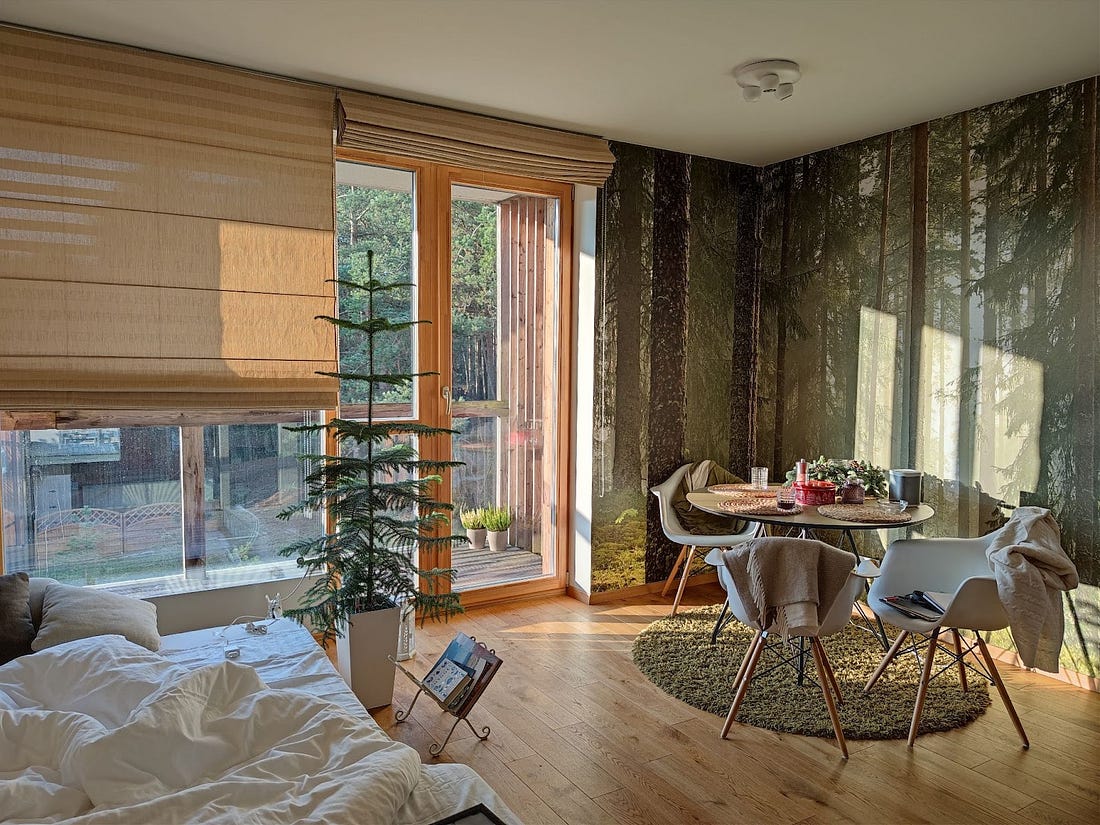Roman Shades For Windows: The Ultimate Buyer's Guide

IN THIS ARTICLE
What’s the most versatile window covering of them all? It just might be the Roman shade.
Roman shades have been around forever, but their long history doesn’t mean that they aren’t a stylish choice for contemporary homeowners. They’re immensely popular and for good reason!
These window treatments can be dressed up or down to suit an array of styles. And because we offer scores of customisation options, we’re confident that there’s a Roman shade out there to suit anyone’s taste.
If you’re thinking about ordering Roman shades for your home or apartment, keep reading. This buyer’s guide will answer all your questions.
What Are Roman Shades?
A Roman shade is a popular window covering style that features soft drapes or crisp folds of fabric when the shade is lifted. They operate like pleated or cellular shades, using a pull cord or a continuous loop of cording to raise and lower the fabric. The cording controls the draping along the bottom of the shade. Because of this, we don’t offer cordless Roman shades.
When you look at Roman shades, you’ll see a lot of variations in the way that the fabric drapes or folds. You can choose among four main types:

Standard Flat Fold
The flat fold style offers a simple, contemporary look. When it is fully lowered, the shade appears flat; when raised, the fabric draws upward in a neat bunch of folds that are reminiscent of cellular shades. This standard type of Roman shade complements floor-length curtains. Working together, they offer homeowners more practical light filtering and privacy options without closing the drapes.
Plain Fold
The crisp, plain-fold style brings more texture and body to the window covering. The fold is visible, even when the shade is completely lowered. When it’s raised, the fold becomes more pronounced. It’s also a heavier, wider fold than the standard flat style. When you think about Roman shades, this is likely the look you’re imagining.
Soft Fold
Sometimes called a “hobbled fold,” this type of shade creates softer, rounder folds while still maintaining a straight edge along the bottom of the treatment. When it’s raised, soft fold Roman shades will have the most voluminous look of all four styles. When it’s lowered, you’ll still be able to see the shape of the curved fold.
European Fold
Also called a “relaxed fold,” this style of Roman shade is what interior designers call “the soft smile.” Unlike the other shade styles, which are more constructed or tailored-looking options, this style doesn’t have a rod sewn into the bottom of the shade. The rod creates a stiff, straight line across the bottom. Without it, the fabric can drape in a natural soft curve.
Why Should You Choose Roman Shades?
There are dozens of different window treatment options. The big question you want answered: Why this one? Why Roman shades? Here’s our answer:
Roman Shades Look Luxe
Our exquisite fabric choices make our Roman shades stand out in the best way possible. Like fine tailoring on a suit, materials matter. Whether you pick a soft linen, a more structured flax or a subtle pattern, these shades look like special orders you shelled out for, even though you didn’t.
Roman Shades Are Stylish
If you’re worried about picking window treatments that date your home, Roman shades just might be your new best friend. They have a long history (we talk about that below) and have never gone out of style. This means that even decades from now, the Roman shades you choose today can look just as current then as they do now.

Roman Shades are Customisable with Optional Upgrades
When you shop for Roman shades, you’ll notice that you have lots of options to choose from. Because they’re made of fabric and come in a variety of fold and drape styles, you can craft just about any look you can dream up.
We also make top-down/bottom-up Roman shades. This option gives you even more flexibility for light filtering and privacy. We can make them with different linings, including a blackout liner that would be appropriate for use in bedrooms.
Roman shades are also available with a range of upgrade options to further customise and get the perfect window treatment for your room.
- Cordless Lift: For instant room darkening, choose a blackout cordless Roman shade with Cordless Lift. You’ll be able to raise the shade from a bar at the bottom without cords getting in the way.
- Continuous Cord Loop Controls: Some shades are controlled by two separate cords, while others have a continuous loop. This feature means you’re less likely to end up with tangled or damaged cords.
- Motorised Lift: Why not skip the cords altogether? Motorised Lift allows you to control your Roman shade at the click of a remote.
- Hobbled Fold: For a more traditional and luxurious look, hobbled fold creates large, soft folds that bunch up at the top and give the shade a pleasant texture when lowered.
- Valances and Cornices: Curtain railings can be unattractive at times. Hide yours beneath an attractive valance or cornice.
- Top-Down / Bottom-Up Lift: With this feature, you can adapt to the moving sun by opening your shade from the top or raising it from the bottom (or both at once).
- Liners: Turn your shade into a total blackout Roman shade with a custom liner, designed to add extra wight and coverage.
See our custom shades buying guide for more information about how you can personalise your shades.
Roman Shades Are Easy to Use
A tilt wand can be difficult for some individuals to manipulate, which makes blinds and some other shades an impractical option. Roman shades use either pull cords or continuous loop cording. These can be easier for arthritic hands to grip.

Are Roman Shades Trendy?
Roman shades have been a popular interior design choice since – you guessed it – Roman times. Ancient Rome was a hotbed of construction, and the shades bearing the civilisation’s name was borne from necessity.
Rumour has it that the first Roman shade had humble origins: Citizens looking to keep the dust out of their homes hung damp towels in their windows. Its evolution is a bit more legendary. Once the Coliseum was opened around 80 A.D., the Romans realised that they needed to erect some sort of covering for the spectators in the tops of the stands.
While modern Roman shades are vertical, these shades were built to be horizontal. They featured draping folds of fabric, but they extended outward, more like an awning than the window covering we would recognise today.
In the nearly 2,000 years since then, Roman shades have been a popular type of shade. We would call them “timeless” rather than “trendy” because this style of window treatment isn’t going anywhere anytime soon.
How to Choose the Right Material for Roman Shades
The fabric options available for Roman shades can seem endless. However, what you need from a practical standpoint from your window coverings can narrow the selections to a manageable few. What should you consider?
How Much Light Do You Need to Block Out?
If you want your window covering to filter out a lot of light, you should choose a fabric that’s heavier, thicker or darker in color. You can also add a lining to your shade, which will improve light filtration. If you want shades that are mostly decorative, go with a thinner, lighter or finer fabric.
Keep in mind that the folds of your Roman shades will always be visible, even if the shade is pulled all the way up to the top of the window frame.
How Much Use Will Your Shades See?
Some fabrics are more delicate than others, so how much you intend to use your shades should play a role in your fabric choices. Note that when we talk about “use,” we mean actively raising and lowering your shades. Occasional use shouldn’t be a problem. Using is every day – for example, opening and closing drapes in a bedroom – might be.
A thinner, sheerer fabric or one with a lot of detailing (think embroidery) will not hold up to as much use as a heavier fabric or one with a tighter weave.

Who Will Be Using Your Shades?
If it’s mostly you, pick what you like. If you’re furnishing a guest room that will see a lot of use or you’re outfitting a space you intend to rent out, however, you’ll likely want to choose a durable fabric in a neutral colour.
Have kids? Take them into account, too. Even older children can be rough on home furnishings.
What Mounting Option Is Best for Roman Shades?
In addition to picking fold styles and fabrics that suit your home’s personality, you also have a few more customisation options to choose from to make your Roman shades suit both your interior design style and your practical needs. One of these is mounting style.

Window mounting terminology sounds strange, but it’s easy to figure out.
An inside mount window shade is one that is hung, or mounted, within the window’s frame. It won’t cover up any of the trim that surrounds the window. You’ll most often see roller shades mounted on the inside, for example. Conversely, an outside mount window shade is hung on top of the window frame, molding or trim, or on the wall above the window.
See? Easy. As long as you measure everything correctly, you’ll be able to mount inside or outside depending on your needs.
While these sorts of choices always come down to personal preference, there are a few details that could sway you one way or the other. The following three questions might help you pick one over the other:
Do Your Windows Have Heavy Trim?
Historic and stately homes often feature exquisite crown molding, baseboards and window trim that adds major character to their interiors. If that’s the case in your home, you won’t want to cover it up with window treatments. In this situation, go with inside mount shades.
Does Your Home Have Low Ceilings?
Plenty of older homes and apartments have lower-than-ideal ceiling heights that make rooms look dark and cramped. However, clever window treatments can create an optical illusion that works in your favour. You can hang outside mount Roman shades at ceiling height. This elongates your windows, making your ceilings look higher and your rooms look larger.

Do You Want to Avoid Light Leaks?
A typical Roman shade doesn’t fit tightly inside or against your window frame; Victorian Roman shades are usually inside mounted, but these will let in natural light. If you want your rooms to be truly dark during daylight hours with minimal gaps between the shade and window, trim or wall, you’ll want to choose an outside mount shade with significant overlap. Think 6 inches or more on both the right and left sides of your windows.
Where to Hang Roman Shades
Roman shades are best suited for living spaces. We see them most frequently in living rooms, family rooms, dens, kitchens and dining rooms. Are there places where you shouldn’t hang them?
Think Twice Before You Hang Roman Shades in a Bedroom
While you can customize your shades to include a blackout liner and increase the amount of overhang, a Roman shade still won’t fit your window snugly. That means that a beam of light slipping between the wall and the shade could wake you up before your alarm does.
Don’t Hang Roman Shades in a Bathroom
A hot bath or shower won’t do the drape of your Roman shades any favours. Humidity can soften crisp pleats and flatten out a gentle fold. Excess moisture and ineffective venting can also create mildew problems in your drapery – yikes!
Bottom Line: Are Roman Shades Right for You?
Roman shades are a versatile window covering that suit a variety of homes and homeowners. But that doesn’t mean they’re the perfect option for every situation. Will they be right for you and your family? That all depends.
You should seriously consider Roman shades if...
- You have a more traditional decorating style. Or contemporary. Or classic. Or mid-century. Or retro. Or modern. Or rustic. Seriously, there’s a Roman shade for every style!
- You want an understated but luxurious feel. While patterned fabric or soft fold Roman shades can create more of a statement, neutral fabrics and simpler fold styles look expensive without drawing your eye away from other design choices.
- You like having lots of customization options. If you want window treatments that look like you, Roman shades offer you the flexibility you’re seeking.
You might want to consider other options if...
- You live in a humid environment where fabric window treatments could become droopy, flat or mildewed. For this reason, Roman shades aren’t good choices for window coverings in bathrooms.
- You have young children. Cordless window blinds or shades are recommended for families with babies, toddlers and young kids who could potentially wrap themselves up in pull cords or continuous loop cords.
- You have pets that like to climb. Cats and other creatures that have a knack for scaling furniture and upholstery could ruin fabric Roman shades in a single afternoon.
- You want window treatments that create a fully dark environment during the day. While you can add blackout liners and plan for significant outside mount overhang, Roman shades can create cracks of light around the window fixture.
- You have allergies or respiratory problems. Fabric shades can attract and collect dust, pollen and pet dander. If you do have health concerns, you might be able to use a spray treatment for upholstered items that will help them repel allergens.
There are lots of window treatments to choose from and we’ll walk you through each and every one of them. Remember: The experts at Factory Direct Blinds are here to help! We’re not happy until you’re happy.






